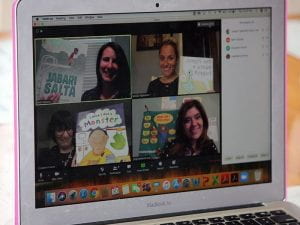Making a rapid transition to distance learning in response to a pandemic is challenging for everyone, but can be especially difficult for students who receive additional supports, their families and the teachers and professionals who work with them. To learn more about how our staff members are working to help all South Orangetown students sustain and continue their progress, the District will share interviews with a variety of staff members as part of a “Supporting All Learners” series in the coming weeks.
From Abkhazian to Vietnamese, SOCSD families collectively speak more than 30 languages. William O. Schaefer Elementary School is home to the District’s largest population of English Language Learners (ELLs), a diverse group of students who are unable to communicate fluently in English but, as individuals, have different language, academic and social-emotional needs.
The WOS English as a New Language Team is led by ENL Team Leader Elizabeth Apicella and includes ENL Teachers Liz Fearen and Jessica Yapkowitz and School Social Worker Jessica Inglis.
How did you prep, as a team, for distance learning?
Yapkowitz: “We made sure all of our students were connected to Google Classroom and that each family had devices. We also made phone calls, sent emails and followed up to make sure all families were able to navigate the technology and felt comfortable using their devices. As a team, we met through Zoom meetings to create Google Slides, packets to send home to students unable to access technology at home for different reasons and ongoing outreach logs.”
Inglis: “I began to reach out to our families to assess and meet basic needs to support ongoing distance learning, such as food service delivery, access to Chromebooks and wifi hotspots and help with applying for free internet service through local providers.”
What, if any, are some of the unique challenges your team has encountered with distance learning so far?
Apicella: “We were very prepared to develop activities and deliver instruction, but found at the onset that other challenges were more pressing. We had students we had not heard from yet at the launch of distance learning, parents expressing concerns over basic needs and connectivity challenges we had not expected. We had to take a coordinated step back to prioritize establishing a consistent line of communication and to address those basic needs. Then, we were able to begin layering on new procedures and routines related to distance learning, little by little. We had to go slow to go fast.”
What does ENL instruction look like in a remote environment?
Apicella: “The short answer is that it looks the same! We are mining through grade level content to ensure that our students can access the activities and instruction and making adjustments to assignments wherever possible. Sometimes that adjustment includes video instructions or the addition of visual aids or supplemental material such as a video or example of the expectation. We’re also developing our own language-based activities for students which include recorded lessons and instructions read aloud. We’re providing targeted, one-on-one support to ensure our students are participating in whole class and small group meetings on Zoom, and participating with them much like in a push-in situation. We’ve developed small group schedules for Zoom lessons as well and have enjoyed a different type of collaboration (distance collaboration!) with classroom teachers and other related service providers in order to meet the needs of ELLs and maintain a daily connection with all of our ELL students and families.”
Yapkowitz: “We’ve been in constant communication with our co-teachers to help modify instruction and create activities to help our ENL students navigate the work that is posted online.”
How are you supporting students at home and partnering with families to support their children in circumstances where parents aren’t English speakers?
Fearen: “Our students are very fortunate to have parents willing to take risks to communicate and learn new technology. As ENL teachers, we have experience communicating with parents across languages, so that helps. As an ENL department, we can communicate in three different languages to support students and families, but where it’s not possible to speak and understand the same language, we use Google Translate to communicate via text messages. It has been a delight to work with older siblings who have stepped up to the plate to guide their younger brothers and sisters successfully through this challenge.”
Apicella: “We’re working really hard to support our ELLs in accessing and utilizing technology available to its fullest potential. At times, our students are working independently, so we have to ensure that they can find what they need to engage in their classwork. Remember, we are asking them to engage in many platforms–Google Classroom, Zoom, Epic, etc.–and engage in a number of daily tech routines which require practice, one-on-one support and direct instruction. Sometimes this means guiding the student through their own learning and experience. Being a Spanish-speaker myself has helped, however the complexity of what we are experiencing transcends language and requires a responsive mindset above all else.”
What are key things that you’ve learned through this process so far? How, if at all, has it impacted your thinking about your own professional practice?
Yapkowitz: “One thing we have learned through this process is to have patience, flexibility and compassion for our students and families. This is a very difficult time for everyone and we need to put our health, families, and mental wellbeing first. We want to be an emotional support to our students and their families as well as their primary teachers. Many of our students have parents who do not speak or understand English and they struggle with using the learning platforms. As a team, we work together to reach all our families and offer the support they need for students to access opportunities equitably. This new style of teaching has impacted our professional practice by allowing us to not only work directly with our students each day, but also given us the opportunity to work more closely with each family on a daily basis.”
Apicella: “We cannot just expect students to meet the expectations of distance learning, we have to take the time to teach them how to meet them. We’ve worked hard to provide supportive structures for distance learning. With this guidance and support, we can say that at the end of this, our students will be more prepared than ever for college, careers and beyond.”
Inglis: “This experience has really emphasized the importance of a coordinated team approach for addressing the many needs of our families: it truly takes a village. There are many barriers to learning outside of language that require adequate support and coordinated effort. As the school social worker, this experience continues to reinforce my belief that in order for students to be available and successful at school, we need to support the whole child, which includes the needs of their families.”


You must be logged in to post a comment.